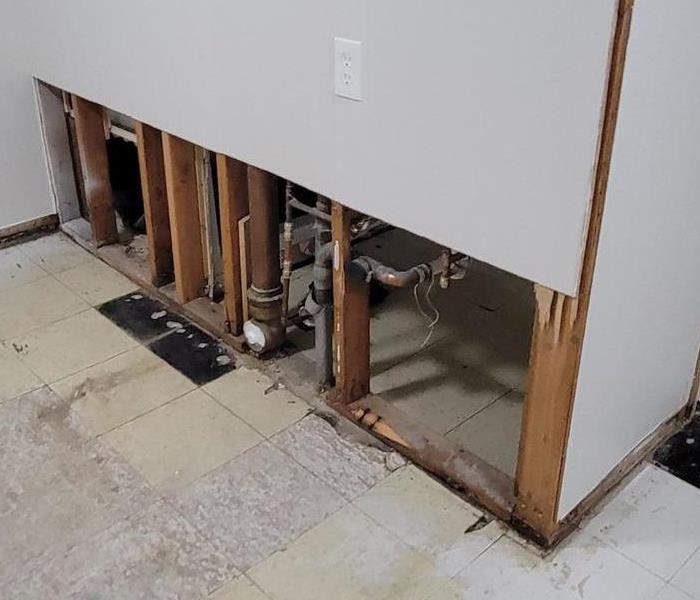Mold and Water Damage Restoration: A Comprehensive Approach to Protecting Your Property
11/7/2024 (Permalink)
Water damage and mold growth are often closely linked, as moisture creates the ideal conditions for mold to thrive. When water damage occurs in a home or commercial building, it’s essential to address both the water damage and the potential for mold growth to ensure a complete restoration. Ignoring one aspect can lead to lingering problems that affect the structure of the property and create additional issues down the line.
In this blog, we'll explore the comprehensive approach needed for effective mold and water damage restoration and how professional services, such as those offered by SERVPRO®, can ensure that your property is fully restored.
Understanding the Link Between Water Damage and Mold
When water infiltrates a building due to leaks, flooding, or other causes, it creates the perfect environment for mold to grow. Mold spores are present in the air, but they require moisture to develop into visible mold colonies. Within 24 to 48 hours of water exposure, mold can begin to grow on wet surfaces, including walls, floors, ceilings, and furniture.
This is why water damage restoration must go hand in hand with mold remediation. If water damage is not properly addressed, mold growth can become a serious problem, potentially leading to structural damage.
Steps in Comprehensive Water Damage and Mold Restoration
Effective water damage and mold restoration requires a multi-step approach to ensure all affected areas are thoroughly treated. Here’s how SERVPRO handles the process:
Initial Assessment and Inspection
The first step in any water damage and mold restoration project is a thorough assessment. SERVPRO technicians inspect the property to identify all areas affected by water damage, including hidden moisture that may not be immediately visible. They also assess areas at risk of mold growth or where mold has already begun to form.
By using specialized tools such as moisture meters and infrared cameras, professionals can detect water damage and mold in hard-to-reach areas like behind walls, under floors, or in ceilings. This comprehensive inspection ensures that no affected area goes untreated.
Water Extraction
After the assessment, the next step is water extraction. This process involves removing any standing water from the property using industrial-grade pumps and vacuums. The faster the water is removed, the less chance there is for mold to grow. SERVPRO's advanced equipment ensures that all excess water is quickly and efficiently removed from the premises.
Drying and Dehumidification
Once the water is extracted, drying and dehumidification are crucial to prevent further damage and mold growth. SERVPRO uses air movers, dehumidifiers, and drying equipment to remove moisture from surfaces and the air. This process can take several days, depending on the extent of the water damage.
During this phase, SERVPRO monitors the drying process to ensure that all moisture levels return to normal. Special attention is given to porous materials like drywall, wood, and carpet, which can retain moisture and become a breeding ground for mold.
Mold Containment and Remediation
If mold is present, the next step is containment and remediation. Mold spores can spread easily through the air, so it’s important to contain the affected area to prevent further contamination. SERVPRO uses containment methods like plastic sheeting and negative air pressure to keep mold spores from spreading to unaffected areas of the property.
After containment, the mold remediation process begins. This involves physically removing mold from surfaces, cleaning or replacing contaminated materials, and using air filtration systems to remove mold spores from the air.
Cleaning and Sanitization
Once the water damage and mold remediation processes are complete, the entire affected area must be thoroughly cleaned and sanitized. SERVPRO uses specialized cleaning agents and antimicrobial treatments to eliminate any remaining traces of mold and bacteria.
This step also involves cleaning personal belongings, furniture, and other items affected by water damage. Carpets, upholstery, and fabrics may need to be professionally cleaned or replaced, depending on the extent of the damage.
Restoration and Repairs
The final step in the comprehensive restoration process is repairing and restoring the property. This can involve minor repairs, such as replacing drywall or painting, or more extensive work, like rebuilding entire sections of the property. SERVPRO ensures that the property is returned to its pre-water damage condition, restoring both the appearance and structural integrity.
Preventing Future Water Damage and Mold Growth
While the immediate water damage and mold issues can be resolved, prevention is key to avoiding future problems. After the restoration process, SERVPRO provides recommendations for preventing water damage and mold growth in the future. Whether the water damage was caused by a leaky roof, broken pipe, or flooding, it’s crucial to repair the source to prevent further damage. Regularly inspecting your home or business for signs of water damage or mold growth can help catch problems early before they become significant issues.
Why Professional Services Matter
While some water damage or mold issues may seem minor, they can quickly escalate if not handled properly. Professional water damage restoration and mold remediation services like those provided by SERVPRO ensure that all aspects of the problem are thoroughly addressed, preventing long-term damage and restoring your property to its original condition. By using advanced equipment, trained technicians, and a comprehensive approach, SERVPRO can efficiently and effectively manage both water damage and mold remediation, saving you time, money, and stress.
Water damage and mold are closely intertwined, and a comprehensive approach is necessary to address both issues. Whether dealing with a burst pipe, flooding, or hidden leaks, it's essential to have professionals like SERVPRO of Johnston County South to handle the situation to ensure that your property is fully restored.

 24/7 Emergency Service
24/7 Emergency Service
